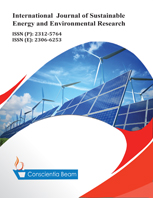Optimal Design of Hybrid Energy System Drives Small-Scale Reverse Osmosis Desalination Plant
DOI:
https://doi.org/10.18488/journal.13.2019.81.48.61Abstract
Different configurations for a hybrid energy system are presented. This study aims to produce 100 m3/day of freshwater for 120,000 people at Nakhl city, North Sinai, Egypt. This simulation selects the optimal design of the hybrid energy system according to the net present cost (NPC), the cost of energy (COE), the gases emissions (carbon dioxide, sulfur dioxide) and the excess system electricity. The hybrid system consists of photovoltaic panels, wind turbines, storage batteries, and a diesel generator. The operation of five different systems is studied to supply the load at an average rate of 557.22 kWh/day with 35.67 kW peak load. In order to minimize the system total cycle cost, both of the photovoltaic modules sizing, the wind turbine production, the number of battery strings and the diesel generator fuel consumption are studied. Homer Pro software is used to select the optimal system configuration. The results illustrate that the hybrid PV/diesel/RO desalination plant system with storage batteries is sustainable and socially accepted system. It consists of 83.5 kW PV panels, a 36.4 kW converter, seven strings of lead-acid batteries and a 50 kW fixed capacity generator. Also, the system achieves the lowest cost of energy and net present cost.

